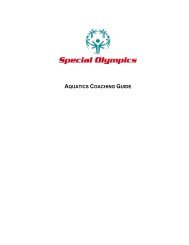BADMINTON Special Olympics Sports Skills Program
BADMINTON Special Olympics Sports Skills Program
BADMINTON Special Olympics Sports Skills Program
Create successful ePaper yourself
Turn your PDF publications into a flip-book with our unique Google optimized e-Paper software.
Daily Performance Record<br />
Purpose<br />
The Daily Pe r f o rmance Record is designed for the teacher/coach<br />
to keep an accurate record of the athletes’daily performance<br />
as they learn the sports skills described in this guide. There<br />
are several reasons why the Daily Performance Record is<br />
valuable to the teacher/coach. The record becomes a<br />
permanent document of the athlete’s progress and helps the<br />
teacher/coach establish measurable consistency in the athlete’s<br />
curriculum. This is extremely important when more than one<br />
teacher/coach works with the athlete.<br />
In addition, the record allows the teacher/coach to be flexible<br />
during the actual instructional session. He or she can break<br />
down the skills into tasks that are more specific than those<br />
indicated in this guide and, thus, meet the athlete’s individual<br />
needs. Last, the record helps the teacher/coach choose proper<br />
skills and tasks, viable conditions and criteria for mastering<br />
the skills and tasks, and correct levels of instruction to suit<br />
the athlete’s learning abilities in future sessions. These<br />
reasons make the Daily Performance Record an important<br />
aspect of an individualized educational program.<br />
Using the Daily Performance Record<br />
At the top of the record, the teacher/coach enters his or her<br />
name, the athlete’s name, the sport, and the sports skills<br />
program level from which the skills are taken. If more than<br />
one teacher/coach works with the athlete, they should enter<br />
the dates that they work next to their names.<br />
<strong>Skills</strong> and Task Analysis<br />
Before the instructional session begins, the teacher/coach<br />
decides what skill(s) will be taught. The teacher/coach makes<br />
this decision based on the athlete’s age, the athlete’s interests,<br />
and his or her mental and physical abilities. The skill should<br />
be a statement or a description of the specific terminal<br />
behavior that the athlete must perform, for example: “Grip<br />
the racket correctly.” The teacher/coach enters the skill on the<br />
top line of the left-hand column.<br />
On the second line, the teacher/coach enters the first task<br />
from the task analysis that describes teaching the skill. Each<br />
subsequent task is entered after the athlete masters the previous<br />
task. Of course, more than one sheet may be used to<br />
record all of the tasks involved in one skill. Also, if the<br />
athlete cannot perform a prescribed task, the teacher/coach<br />
may break down the skill into even more specific tasks that<br />
will allow for the athlete’s success.<br />
<strong>Special</strong> <strong>Olympics</strong> Badminton <strong>Sports</strong> <strong>Skills</strong> <strong>Program</strong><br />
Conditions and Criteria for Mastering<br />
After the teacher/coach enters the skill and the first task on<br />
the record, he or she then decides on the conditions and<br />
criteria by which the athlete must master the skill and the<br />
task. Conditions are special circumstances that define the<br />
manner in which the athlete must perform a skill; for ex a m p l e :<br />
“ g iven a demonstration, and with assistance.” The teacher/coach<br />
should always assume that the ultimate conditions in which<br />
the athlete masters a skill are, “upon command and without<br />
assistance.” Therefore, the teacher/coach should not feel<br />
obligated to enter these conditions in the record next to the<br />
skill entry. Howeve r, the teacher/coach should enter conditions<br />
next to the task entry and must select conditions that suit the<br />
task being performed and the individual abilities of the athlete.<br />
The teacher/coach should arrange the tasks and conditions in<br />
such a way that as the athlete learns to perform the skill, task<br />
by task, he or she also gradually learns to perform it upon<br />
command and without assistance.<br />
Criteria are the standards that determine how well the skill<br />
or task must be performed. A nonimpaired athlete should be<br />
a ble to perform a skill “upon command and without assistance,<br />
90 percent of the time” for the teacher/coach to consider that<br />
the athlete has mastered it. But in the case of the <strong>Special</strong><br />
O ly m p i c sathlete, the teacher/coach should determine a<br />
standard that more realistically suits the athlete’s mental and<br />
physical abilities; for example: “into a wider than normal<br />
target, six out of 10 times.” Given the varied nature of tasks<br />
and skills, the criteria might involve many different types of<br />
standards, such as amount of time, number of repetitions,<br />
accuracy, distance, or speed.<br />
5 7

















